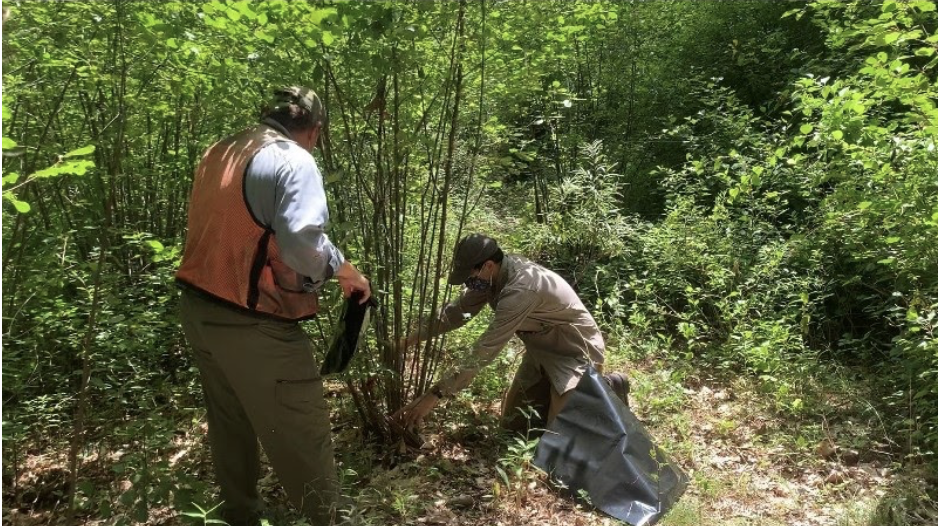
Windham County Forester Sam Schneski and Jack Minich, Americorp Intern with Vermont Land Trust demonstrate the use of buckthorn baggies at a demonstration site.
In 1950, ecologist Charles Elton first used the militaristic term “invasion” to label the attack by unwanted plants and animals spreading across the American landscape. This attack — the proliferation of invasive species — has a well-documented, global history, and now ranks as the second greatest threat to Vermont’s biodiversity. Whether deliberate or unintentional, invasive species pose a significant threat to native animal and plant communities and can cause extinctions as species compete for limited resources, reduced biodiversity, and altered terrestrial or aquatic habitats. The landscapes and cultures that define Vermont, whether commercial, agricultural, or recreational, depend on a healthy native ecosystem, but the scale of Vermont’s invasive species challenge is beyond the capabilities of a single individual or entity.
To support landowners’ efforts to be responsible stewards of the southeastern Vermont landscape, Windham County Natural Resources Conservation District set out to incorporate the challenge into its mission. Programs including Trees for Streams, outreach and education under Vermont’s Clean Water Initiative, and tactical basin planning, form the foundation of its mission and continue to be heavily impacted by invasives.
In response to the growing threat, Windham County NRCD led the organization and launch of the Southeast Vermont Cooperate Invasive Species Management Association (CISMA), a partnership of local organizations with a vested interest in maintaining ecological health through invasive outreach, prevention, and management. Windham County NRCD worked with the Vermont Land Trust to identify key partners, individuals, and organizations that have been invaluable in CISMA’s mission: U.S. Natural Resources Conservation Service, Windham Regional Commission, Silvia O. Conte National Fish and Wildlife Refuge, the Windham County Forester, private consulting foresters, and the Windmill Hill Pinnacle Association.
With funding from the New England Grassroots Environmental Fund Grow Grant and Vermont Community Fund’s Spark Grant, the SE VT CISMA organized a series of invasive species webinars hosted last fall by Windham County NRCD. The programming aimed to help landowners identify and remove invasive species, with emphasis on early detection of priority species. Additionally, the series covered mechanical and chemical treatment options and provided a comprehensive assessment of the strengths and weaknesses of varying approaches. The webinar series was well-attended by individuals across the region and state; over 450 people participated in the series, with hundreds of more views on YouTube. While much of the future programming will occur in-person in southeast Vermont, the explosion of virtual communication has the power to deliver the webinar’s message far beyond the Southeast and inspire creation of similar groups across the state.
Windham County NRCD’s plans for 2021 include a community support program bringing technical assistance to Brattleboro and Bellows Falls residents. The goal is to create more equalized opportunities for technical assistance across constituents, whether landowners or woodlots. Windham County NRCD intends to engage with neighborhood associations to remove invasive species from city parks and other public spaces and replace them with native species that have high food, wildlife, and aesthetic value, and that can restore ecosystems to their natural state. The county is mainly composed of privately owned and operated forested land, which places greater importance on landowner management decisions, outreach, and education. The district also tackles the issue across the county’s valuable aquatic habitats by serving as the administrator for three public access greeter programs and ongoing Water Chestnut survey and removal work in the Connecticut River.
Finding new invasives and quickly stopping their spread can prevent large infestations that become costly or even impossible to combat. Increased education can create exponential action, as knowledge is publicly and freely disseminated. Windham County NRCD hopes that by connecting with landowners and communities it will inspire a multifaceted response to the problem, thwarting the attack and protecting Vermont’s natural resources.
The webinar series can be found on the district webpage.






